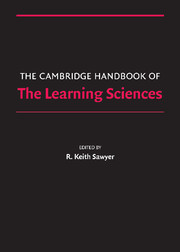Book contents
- Frontmatter
- Contents
- Preface
- Contributors
- 1 Introduction
- PART I FOUNDATIONS
- PART II METHODOLOGIES
- PART III THE NATURE OF KNOWLEDGE
- PART IV MAKING KNOWLEDGE VISIBLE
- PART V LEARNING TOGETHER
- PART VI LEARNING ENVIRONMENTS
- Afterword: After How Comes What
- Epilogue: The Fundamental Issue in the Learning Sciences
- Author Index
- Subject Index
Afterword: After How Comes What
Published online by Cambridge University Press: 05 June 2012
- Frontmatter
- Contents
- Preface
- Contributors
- 1 Introduction
- PART I FOUNDATIONS
- PART II METHODOLOGIES
- PART III THE NATURE OF KNOWLEDGE
- PART IV MAKING KNOWLEDGE VISIBLE
- PART V LEARNING TOGETHER
- PART VI LEARNING ENVIRONMENTS
- Afterword: After How Comes What
- Epilogue: The Fundamental Issue in the Learning Sciences
- Author Index
- Subject Index
Summary
In a conversation about social science, Marvin Minsky – who was famous for his caustically insightful witticisms – once said: “Anything that calls itself science isn't.” Socratically stung by this remark, over the years I have built up a collection of features a would-be new science might borrow from disciplines that do not proclaim their science-ness in their names. Keith Sawyer positions this volume as number two after How People Learn in the evolution of a new science, the learning sciences (see Preface, this volume). Perhaps a sample from my collection, presented as an afterword to number two, might prefigure a foreword to number three.
A Sense of the Fundamental
Consider the speeds of light, of sound, and of the bullet train. Each is important in its context but physicists would agree that the first has the special status of being fundamental. This volume treats many important ideas about learning. But our still embryonic science has not yet developed a consensus about which ideas are fundamental.
At critical times the mature sciences have identified critical problems whose solutions would spawn theories with fundamental consequences: Is light a particle or a wave? Is there a universal decision procedure for mathematics? What is the genetic code? From time to time one or another theory of learning has enjoyed a heady period of seeming to have a similarly fundamental status – examples include behaviorism, Piaget's theories, and information processing models.
- Type
- Chapter
- Information
- The Cambridge Handbook of the Learning Sciences , pp. 581 - 586Publisher: Cambridge University PressPrint publication year: 2005
- 1
- Cited by



